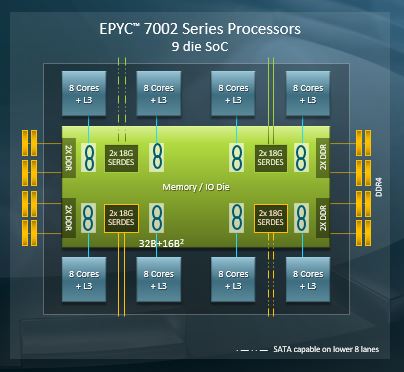AMD and SUSE – world records with a great ecosystem of partners
Recently, AMD announced its new EPYCTM 7002 Series Processors targeted at data center workloads.
The processors, according to AMD, “feature up to 64 ‘Zen 2’ cores and deliver performance leadership across a broad number of enterprise, cloud, and high performance computing (HPC) workloads.”

As part of their original announcement, AMD unveiled 80 world records with key Independent hardware vendors, such as Hewlett-Packard Enterprise, Lenovo, Gigabyte, and SuperMicro. Since then, the list has expanded to a total of 107 records (as of 19-SEP-2019).
SUSE by the numbers
SUSE had a stellar participation, with 45 of the 107 records posted leveraging SUSE Linux Enterprise Server. Let’s review the figures:
- Nine SPEC CPU2017 world-records with 1 and 2-socket systems. The SPEC CPU2017 focuses on compute intensive performance and stresses the processor, memory subsystem and compiler.
- Five SPEC ACCEL (OpenACC and OpenCL), one SPEC MPI and one SPEC OMP world-records with 1-socket systems. The SPEC ACCEL benchmark is interesting since as SPEC organization states it “tests performance with computationally intensive parallel applications running OpenACC and OpenML for target offloading APIs”.
- Twenty SPECjbb2015 world records for both 1 and 2-socket systems. The SPECjbb benchmark measures performance for Java-based applications and leverages the latest features.
- Six SPECpower_ssj2008 world records with 1 and 2-socket systems. The SPECpower benchmark is focused on power efficiency and continues to gain in importance given government and business focus on power consumption and generation needs.
- One SPECvirt_sc2013 2-socket world record which measures performance of virtualized platforms.
- Two SAP SD Standard Application Benchmark world records on 2-socket systems. As SAP explains “SAP Standard Application Benchmarks test the hardware and database performance of SAP applications and components”.
But let’s have the engineering heads explain it in their own words:
 “The success of AMD and the 2nd Gen AMD EPYC processor involves the active participation of the entire datacenter ecosystem, including operating system providers like SUSE,” said Raghu Nambiar, corporate vice president and CTO, AMD application engineering. “The record setting performance of our processors was supported by SUSE Linux Enterprise Server across a number of benchmarks and AMD is grateful for the ongoing collaboration with the SUSE team.”
“The success of AMD and the 2nd Gen AMD EPYC processor involves the active participation of the entire datacenter ecosystem, including operating system providers like SUSE,” said Raghu Nambiar, corporate vice president and CTO, AMD application engineering. “The record setting performance of our processors was supported by SUSE Linux Enterprise Server across a number of benchmarks and AMD is grateful for the ongoing collaboration with the SUSE team.”
“The 2nd generation, Zen2-based AMD EPYC processor family offers formidable processing power, and SUSE is proud to be able to unlock it for applications in close collaboration with AMD. The record setting results in the benchmarks are a proof of the value of this work,” said Vojtech Pavlik, vice president of SUSE Labs.
Why SUSE Linux Enterprise Server?
When we look at the number of benchmarks as well as their type and complexity, it serves to highlight key SUSE Linux Enterprise Server features that may be sometimes overlooked:
 Major kernel updates – In alternate service packs releases of SUSE Linux Enterprise Server, – SUSE will perform a kernel version bump as well as a stack upgrade. Releases are commonly known as Tick-Tock and on “Tock” (or even versions), you`ll see the bump. This is particularly important when trying to adopt new or significantly improved hardware technologies and/or features.
Major kernel updates – In alternate service packs releases of SUSE Linux Enterprise Server, – SUSE will perform a kernel version bump as well as a stack upgrade. Releases are commonly known as Tick-Tock and on “Tock” (or even versions), you`ll see the bump. This is particularly important when trying to adopt new or significantly improved hardware technologies and/or features.
Modular nature – SUSE Linux Enterprise Server is built around the concept of modules, which allows the user to shape the product according to her/his needs. Each module has a clearly defined scope (ex: web development, public cloud, and others). Furthermore, the modular nature allows for different package update cycles. For example: Development tools and compilers may be updated yearly while a legacy module may update every eighteen months.
It’s all about the eco-system!
There are two other company attributes that, in my humble opinion are also reflected:
 Engineering focus: which brings us the ability to closely engage with silicon vendors like AMD. SUSE had a front-row in the early stages of upstream enablement.
Engineering focus: which brings us the ability to closely engage with silicon vendors like AMD. SUSE had a front-row in the early stages of upstream enablement.
Strategic Alliances: Our world-class engagement with strategic partners like Hewlett-Packard Enterprise, Dell EMC, Lenovo, Cisco, and SuperMicro ensures that SUSE Linux Enterprise Server is available to the largest possible number of platforms as well as optimized to take advantage of new processors in a timely fashion.
Additional information on AMD’s new world records, can be found at: https://www.amd.com/en/processors/epyc-world-records
For more information on SUSE Linux Enterprise Server modular approach or tuning details, see https://documentation.suse.com/sles/15-SP1/ – Specifically, the Modules and Extensions Quick Start, System Analysis and Tuning Guide as well as the Performance Analysis, Tuning and Tools on SUSE Linux Enterprise Products.
And for more information on our partner relationships, see: https://www.suse.com/partners/find-partner/
AMD, the AMD logo, EPYC, and combinations thereof are trademarks of Advanced Micro Devices, Inc.
Related Articles
Oct 05th, 2022
SUSE documentation survey—share YOUR feedback!
Mar 17th, 2023
Comments
I don’t have any idea about suse but AMD is already more popular so everyone knows it. Without any doubt, I support AMD.